You’ve likely admired the intricate dotted patterns on ancient Etruscan jewelry without realizing the incredible skill behind each tiny golden sphere. Online granulation courses now make this 2,700-year-old technique accessible from your workshop, but there’s an essential detail most beginners overlook that separates amateur attempts from museum-quality results. The difference lies in understanding why these microscopic granules bond without modern solder—a secret that digital masterclasses can finally reveal.
Ancient Origins of Etruscan Granulation Techniques
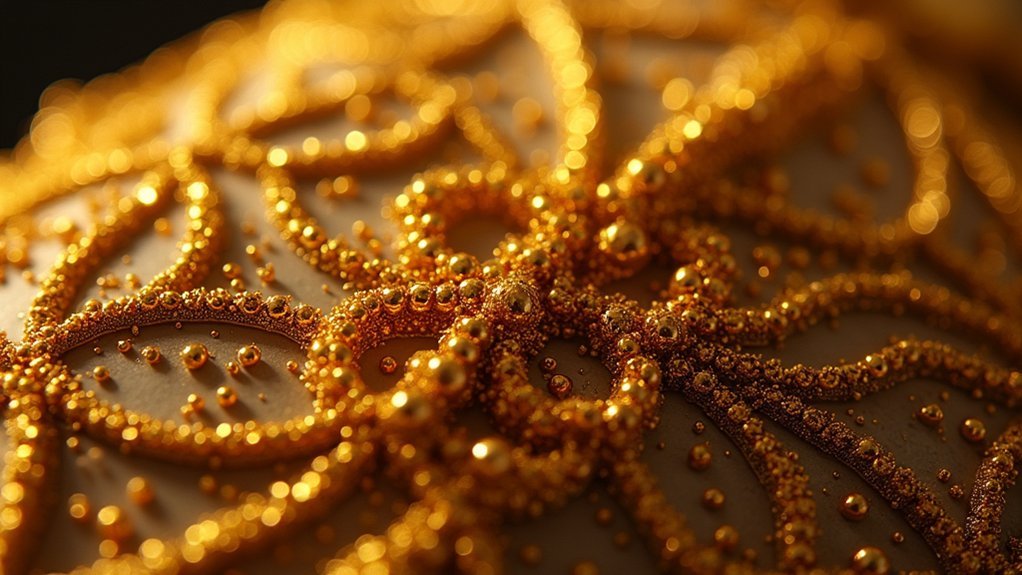
When you examine the ancient burial sites of central Italy, you’ll discover that Etruscan artisans mastered granulation techniques as early as the 8th century B.C., creating jewelry that would mystify craftsmen for millennia.
These skilled metalworkers developed sophisticated methods to bond tiny gold spheres, some measuring just 0.14mm, onto repousséd gold surfaces.
You’ll find their innovative approach involved colloidal soldering, combining tragacanth gum with copper salts to achieve strong bonds at lower temperatures.
This ancient granulation process became the Etruscans’ signature technique, distinguishing their jewelry from other contemporary cultures.
Their advanced craftsmanship reflected sophisticated social structures, with elaborate granulated pieces serving as status symbols buried alongside wealthy individuals in richly appointed tombs throughout central Italy.
Digital Learning Platforms for Traditional Jewelry Craftsmanship
Digital learning platforms have revolutionized how you can master the intricate art of Etruscan granulation without stepping foot in a traditional workshop.
These platforms offer extensive courses teaching ancient techniques like colloidal soldering and fusing, providing detailed online tutorials for creating uniform gold or silver granules. You’ll gain valuable historical context about Etruscan jewelry craftsmanship while learning precise bonding processes from home.
Master ancient Etruscan granulation techniques through comprehensive online courses that blend historical craftsmanship with modern digital accessibility.
The collaborative learning environment connects you with experienced artisans through interactive forums where you can share tips and receive feedback.
Many platforms feature virtual workshops with live demonstrations, letting you witness granulation techniques in real-time and ask instructors direct questions.
This digital approach preserves traditional jewelry craftsmanship while making these specialized skills accessible to modern learners worldwide.
Understanding the Three Primary Granulation Methods
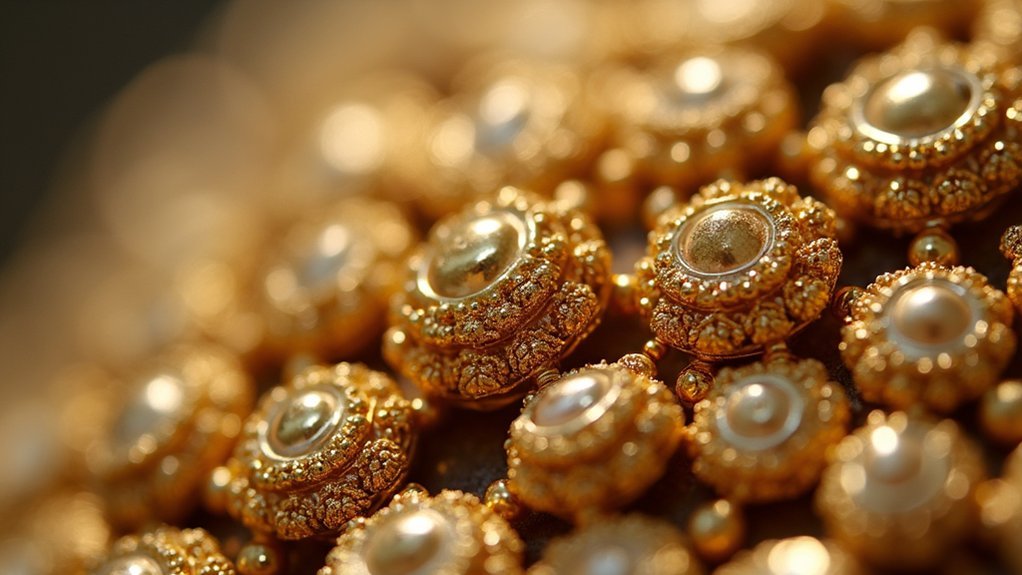
You’ll master Etruscan granulation by understanding three distinct methods that ancient craftsmen perfected over centuries.
Hard soldering relies on capillary action with lower melting point materials, while fusion welding uses heat alone to bond granules without any additional solder.
Colloidal soldering offers a middle ground, using copper salt mixtures that create strong bonds at controlled temperatures.
Hard Soldering Technique
Master the hard soldering technique by applying lower melting point solder to bond granules through capillary action. This method requires precise positioning of tiny solder pieces near each granule’s contact points with the base metal. Your success depends on meticulous placement and controlled heating to achieve strong bonds without damaging delicate granules.
Key considerations for effective hard soldering:
- File solder into powder and mix with flux – This improves application ease and enhances bond strength during the heating process.
- Expect multiple heating cycles – You’ll often need hundreds of repeated heating sessions to achieve desired results.
- Control surplus solder carefully – Excess material can fill gaps between granules, complicating your piece’s final appearance.
These soldering techniques demand patience and precision, making hard soldering one of the most challenging granulation methods.
Fusion Welding Method
The second primary technique, fusion welding, eliminates solder entirely by relying on controlled heat to create molecular bonds between granules and base metal. You’ll position your granules on metal sheets with nearly identical diameters to guarantee ideal heat distribution during the firing process. This method demands precise temperature control—you must bring both materials to their melting point without causing structural collapse.
| Fusion Welding Element | Requirement |
|---|---|
| Temperature Control | Precise melting point timing |
| Sheet Thickness | Nearly same as granule diameter |
| Heat Source | Kiln below + torch above |
| Success Indicator | Flash of light at fusion |
| Final Result | Seamless bond formation |
You’ll know you’ve achieved success when you see that characteristic flash of light, indicating perfect fusion welding has occurred.
Colloidal Soldering Process
While fusion welding requires precise temperature control, colloidal soldering offers ancient craftsmen a more forgiving approach that operates at lower temperatures. This ancient technique, perfected by Etruscans, uses a specialized flux-solder mixture containing tragacanth gum and copper salts to bond granules to a metal surface effectively.
The colloidal soldering process involves three critical steps:
- Surface preparation – You’ll paint the metal surface with the colloidal mixture to create ideal bonding conditions.
- Granule placement – You’ll carefully arrange granules in your desired pattern while the mixture remains workable.
- Controlled firing – You’ll heat the piece to approximately 890°C in a reducing atmosphere, causing copper diffusion.
At this specific melting temperature, copper salt releases and penetrates both granules and base metal, creating invisible joints that showcase advanced Etruscan metallurgical knowledge.
Creating Perfect Spherical Granules From Precious Metals
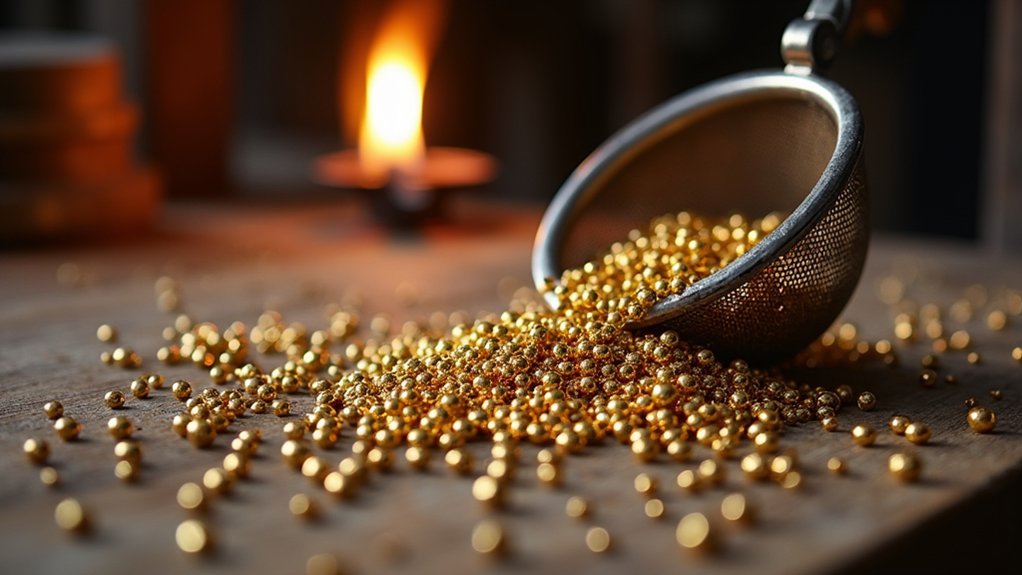
Creating perfect spherical granules from precious metals begins with cutting high-karat gold or silver wire into uniform segments of 1-2 mm length. This precision guarantees consistent heating during the granulation process essential for authentic Etruscan jewelry.
| Step | Process |
|---|---|
| Preparation | Cut wire into 1-2mm segments for uniformity |
| Heating | Place small granules in crucible with powdered charcoal |
| Finishing | Cool, clean, and sort by size |
You’ll heat the metal segments in a crucible with powdered charcoal, which prevents oxidation while helping form spherical shapes. The heating process requires careful control—you must catch the precise moment of fusion to prevent granules from collapsing or fusing together. After cooling, clean and sort your precious metal granules by size for consistent application in your granulation work.
Mastering Colloidal Soldering in Virtual Workshops
You’ll master ancient copper salt techniques through hands-on virtual practice that replicates the precise chemical reactions Etruscan artisans perfected centuries ago.
Your virtual temperature control methods will simulate the critical 890°C eutectic point, allowing you to experiment with firing atmospheres without wasting precious materials.
These digital fusion practice sessions let you troubleshoot granule displacement and incomplete bonding in real-time, building expertise before working with actual gold and silver.
Ancient Copper Salt Techniques
Mastery of colloidal soldering transforms modern artisans into skilled practitioners of ancient Etruscan granulation techniques.
The Etruscans used sophisticated copper salts combined with tragacanth gum to achieve invisible joints between granules and base metals. Your colloidal mixture of tragacanth creates a powerful bonding agent that activates at precisely 890°C.
The process begins with three critical steps:
- Surface Preparation – Paint your metal surface with the copper salt mixture.
- Granule Placement – Carefully arrange granules while monitoring melting temperature the granules can withstand.
- Firing Control – Maintain reducing atmosphere conditions for ideal copper diffusion.
At the eutectic temperature, copper salts release and diffuse into contact points, creating strong bonding without visible solder lines.
This ancient technique requires precise timing and temperature control to replicate authentic Etruscan craftsmanship successfully.
Virtual Temperature Control Methods
Modern digital platforms now enable jewelers worldwide to master these temperature-sensitive techniques through immersive virtual workshops. You’ll learn precise temperature control methods essential for successful granulation without visible solder joints.
| Temperature Stage | Critical Details |
|---|---|
| Preparation | Mix tragacanth gum with copper salts for colloidal solution |
| Application | Arrange granules on metal surface with colloidal mixture |
| Firing Process | Monitor eutectic soldering at exactly 890°C |
| Atmosphere Control | Maintain reducing environment throughout heating |
Virtual instruction guides you through digital temperature simulation tools that replicate real firing conditions. You’ll practice adjusting heat levels while monitoring copper diffusion for ideal bonding. These workshops demonstrate how reducing atmosphere affects the melting point, ensuring your granules achieve strong adhesion to the base metal without traditional solder materials.
Digital Fusion Practice Sessions
Immersive digital platforms revolutionize how artisans perfect the delicate art of colloidal soldering, transforming complex Etruscan granulation techniques into accessible virtual experiences.
You’ll master flux-solder preparation using tragacanth gum and copper salts through these digital fusion practice sessions, learning precise granule placement without material waste.
Advanced software visualizes heat distribution patterns, helping you identify the critical 890°C eutectic temperature for ideal copper diffusion.
You’ll develop timing skills essential for successful granulation while exploring historical contexts of ancient Etruscans’ metalworking mastery.
Key benefits of virtual workshops include:
- Risk-free experimentation – Practice complex techniques without damaging precious metals or granules
- Real-time analysis – Monitor temperature fluctuations and flux-solder behavior instantly
- Historical integration – Access authentic Etruscan methods and cultural insights simultaneously
Temperature Control and Fusion Techniques Online
Three vital elements determine success in Etruscan granulation fusion: precise temperature control, strategic heat application, and perfect timing.
Your fusion technique relies heavily on maintaining ideal temperature ranges where granules must reach their melting point without overheating the base metal. You’ll need to master precise heating methods that prevent granule collapse while ensuring seamless bonding.
The dual-heating approach works best—heat granules from below using a small kiln while applying torch heat from above. This creates the signature flash of light indicating successful fusion.
Even heat distribution becomes essential, so you’ll want to use a metal sheet matching your granules’ diameter. Modern electric current integration can enhance your welding efficiency and maintain consistent temperature control throughout the granulation process.
Essential Tools and Materials for Home Practice
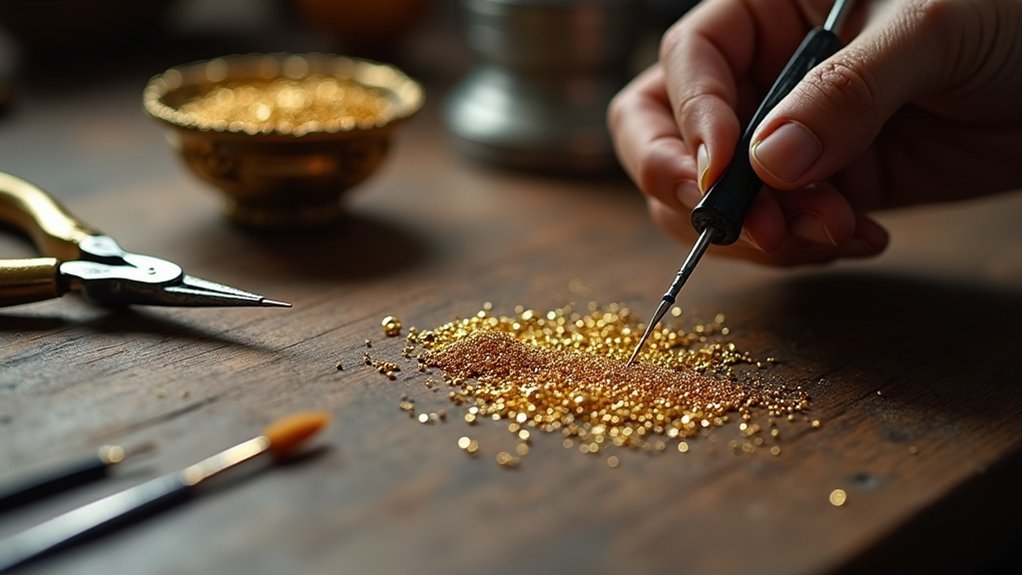
Having mastered these temperature control fundamentals, you’ll need specific essential tools and materials to practice Etruscan granulation at home. This ancient technique requires precision equipment and quality materials for successful results.
Your workspace should include:
- Heating Equipment – A jeweler’s torch for precise temperature control, crucible for melting granules, and soldering board for safe arrangement during the process.
- Metal Materials – High-karat gold (22 kt) or silver alloys that resist oxidation, plus rolling mill or metal shears to create thin metal sheets and wire segments for granule production.
- Supporting Materials – Charcoal powder prevents granules from sticking during firing, while flux like borax enhances solder flow for proper bonding between granules and base metal during heating.
Hard Soldering Applications in Modern Granulation
You’ll need to master capillary action’s role in drawing molten solder between granule contact points for successful modern granulation.
Integrating flux with your powdered solder creates bonding challenges that require careful material ratios to prevent overflow into decorative gaps.
Your temperature control methods must achieve precise heating cycles that melt the solder without compromising the granules’ structural integrity.
Capillary Action Properties
While ancient Etruscans relied on fusion welding techniques, modern granulation artisans harness capillary action through hard soldering to achieve similar stunning results.
You’ll find that capillary action draws liquid solder into microscopic gaps between granules and your base metal, creating incredibly strong bonds. This process binds metal items together more effectively than traditional methods.
Here’s how you can optimize capillary action in your granulation work:
- Position minuscule solder pieces precisely near each contact point where small spheres meet the base metal
- Use flux-enhanced lower melting point solders that flow readily into tight spaces under heat
- Select high karat gold (22 kt) to maintain proper melting temperatures without oxidation issues
You’ll often repeat heating cycles multiple times, ensuring effective capillary action for each granule placement in complex designs.
Flux Integration Challenges
Why does flux integration pose such formidable challenges in modern granulation work?
You’ll find that achieving proper bonding between granules and sheet metal requires precise flux application. The flux integration must clean metal surfaces effectively while avoiding interference with the granulation process.
You can’t simply apply excess flux-solder powder, as this creates uneven surface textures when solder fills gaps between granules.
Too much flux actually hinders the fusing effect you’re trying to achieve. Conversely, insufficient flux leads to poor adhesion and oxidation problems.
You’ll need to position extremely small solder pieces accurately near contact points, utilizing capillary action effectively.
The wrong flux choice can dislodge granules during heating, compromising your entire piece.
Success demands finding that critical balance where flux enhances bonding without overwhelming the delicate granulation process.
Temperature Control Methods
Three critical temperature zones demand your attention when executing hard soldering in modern granulation work. You’ll need precise temperature control to maintain solder at 890°C while protecting your granules and base metal from damage.
Electric soldering equipment helps you achieve consistent heating patterns that prevent oxidation during the granulation process.
Your temperature control strategy should focus on:
- Monitoring solder melting points – Keep temperatures below your base metal’s threshold to guarantee proper capillary action.
- Positioning heat sources strategically – Direct heating away from delicate granules while maintaining adequate flow.
- Timing heating cycles precisely – Allow controlled cooling between multiple soldering process cycles.
You’ll prevent granule distortion by carefully controlling heat distribution across your workpiece, guaranteeing uniform bonding without compromising the intricate details that define quality granulation.
Contemporary Adaptations of Ancient Etruscan Designs
As contemporary jewelers rediscover the timeless beauty of Etruscan granulation, they’re breathing new life into techniques that once adorned the elite of ancient Italy.
You’ll find modern artisans skillfully adapting Etruscan culture’s legendary jewelry-making methods, utilizing high-karat gold and silver to create stunning contemporary design pieces. These craftspeople maintain the aesthetic principles of ancient techniques while incorporating advanced technologies for precision granulation work.
Today’s adaptations often feature vibrant colored gemstones and lustrous pearls, seamlessly blending historical granulation with current fashion trends.
You can now learn these time-honored methods through specialized workshops and courses, where new generations of goldsmiths master traditional skills.
Artists are also exploring innovative combinations, merging granulation with modern design elements to guarantee Etruscan craftsmanship continues evolving in today’s jewelry world.
Online Communities and Expert-Led Masterclasses
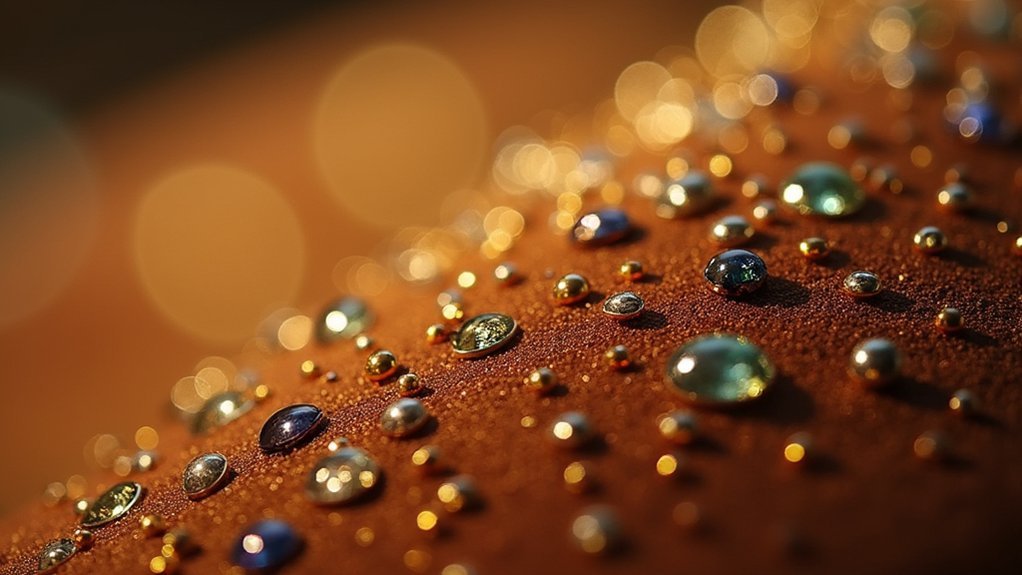
Where can you find the most thorough resources for mastering Etruscan granulation techniques? Online communities and expert-led masterclasses offer extensive learning experiences for artisans seeking to perfect this ancient craft.
These platforms connect beginners with seasoned craftsmen through forums and social media groups where you’ll discover shared techniques and inspiration.
Digital communities bridge the gap between novice artisans and master jewelers, fostering collaborative learning through shared expertise and creative inspiration.
Expert-led masterclasses provide structured instruction covering:
- Essential techniques – granule creation, fusing, and colloidal soldering methods
- Historical context – cultural significance of Etruscan jewelry and its evolution
- Contemporary applications – integrating ancient methods into modern jewelry design
You’ll gain access to video tutorials, live workshops, and digital archives featuring scholarly articles.
These resources help you understand granulation’s precision requirements while appreciating the cultural heritage behind each technique, enhancing both your technical skills and artistic confidence.
Troubleshooting Common Granulation Challenges Remotely
While mastering Etruscan granulation through online resources offers tremendous advantages, you’ll inevitably encounter technical challenges that require immediate solutions during your practice sessions.
When tiny granules don’t adhere properly, guarantee uniform sizing and proper charcoal powder coating before firing. If granules are positioned using flux or solder but still fall off after joining, verify you’re using matching alloys and appropriate temperatures.
Common problems with granulation are usually related to inconsistent heating or sudden temperature changes that distort your work. Since traditional Etruscan methods rely on use of heat alone without modern solders, controlling your flame becomes critical.
Whether working with gold and sterling silver, utilize video tutorials for real-time troubleshooting guidance when issues arise during remote learning.
Building Professional Skills Through Digital Certification Programs
Digital certification programs transform your granulation practice into professionally recognized expertise by providing structured curricula that cover everything from historical context to advanced technical mastery.
These online courses connect you with expert instructors who understand ancient craftsmanship techniques, ensuring you’ll learn authentic Etruscan methods through video tutorials and step-by-step guides.
Your professional skills development includes:
- Technical Mastery – Master granule creation, soldering methods, and design principles through interactive learning modules
- Professional Credentials – Earn certifications that enhance your jewelry making portfolio and career prospects
- Flexible Learning Paths – Access beginner foundations or advanced workshops that accommodate your current skill level
Digital certification programs offer the feedback and community support you need while building expertise that’s valuable for jewelry design and restoration careers.
Frequently Asked Questions
What Is Etruscan Granulation?
You’ll find Etruscan granulation is an ancient jewelry-making technique where you bond tiny gold spheres onto surfaces. You’re creating intricate designs using granules as small as 0.14mm through specialized soldering methods.
What Is Etruscan Style Jewelry?
You’ll recognize Etruscan style jewelry by its intricate granulation technique, high-karat gold construction, and nature-inspired motifs. It’s characterized by detailed geometric patterns, mythological designs, and exceptional metalworking craftsmanship from ancient times.
What Is Granulation Jewelry?
You’ll find granulation jewelry features tiny metal spheres fused onto surfaces, creating intricate decorative patterns. You can achieve this ancient technique through various soldering methods that bond precious metal granules to jewelry bases.
What Is the Etruscan Gold Technique?
You’ll find the Etruscan gold technique involves fusing tiny gold granules onto jewelry using colloidal soldering with copper salts and plant gum, creating intricate patterns without visible joints through masterful craftsmanship.
In Summary
You’ll discover that Etruscan granulation jewelry making online transforms ancient techniques into accessible digital education. Through expert-led workshops and virtual communities, you’re connecting with master artisans who’ll guide you through colloidal soldering and granule creation. You can’t replicate the hands-on experience entirely, but these platforms offer extensive resources, troubleshooting support, and certification programs. You’re preserving millennia-old craftsmanship while building contemporary skills that’ll elevate your jewelry-making expertise to professional levels.

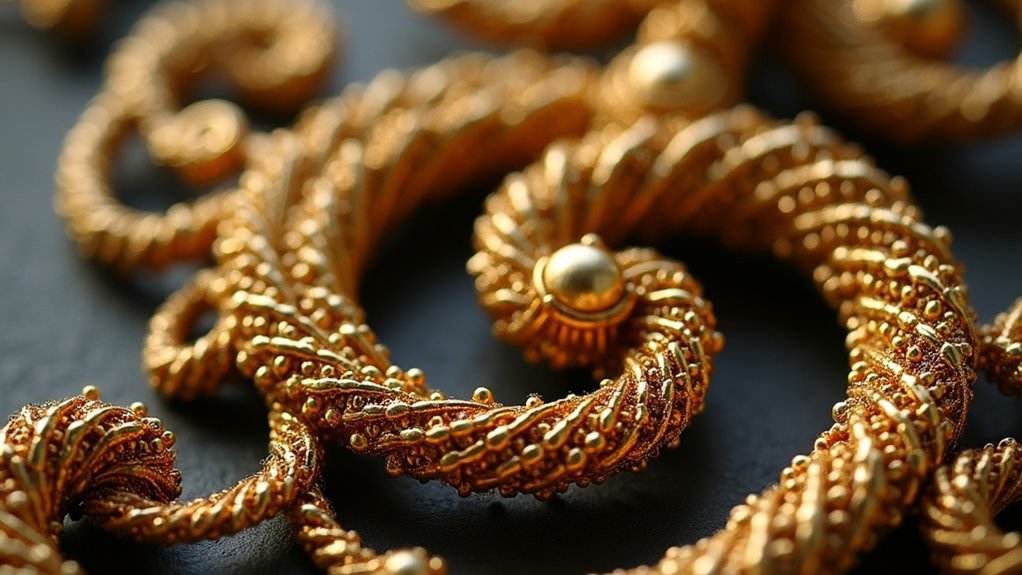



Leave a Reply